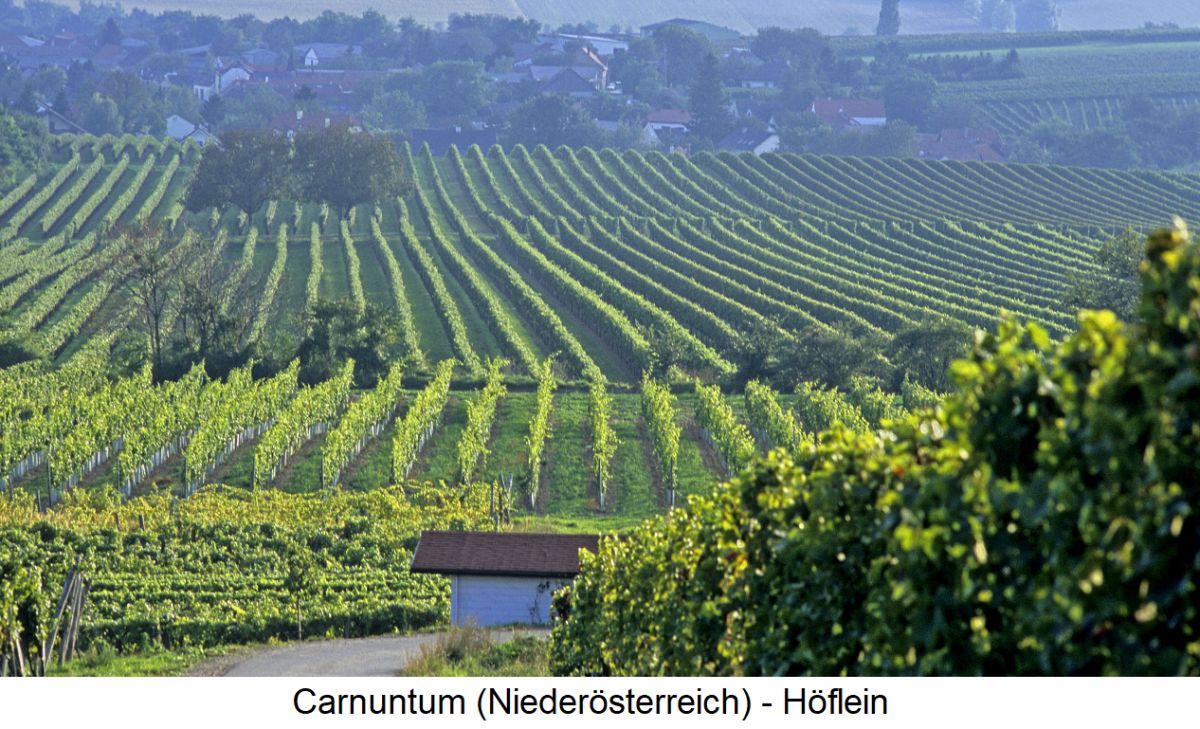Since the 2019 vintage, wine-legally defined DAC area (specific wine-growing region) in the Austrian wine-growing region of Lower Austria (generic wine-growing region). See under Carnuntum.
Carnuntum
One of the eight specific wine-growing districts in the Austrian province or generic wine-growing region of Lower Austria. In 1993, the districts of Donauland (since the 2008 vintage Wagram) and Carnuntum, which until then had formed a common winegrowing area, were separated. The Celts and later the Romans already practised viticulture here. In the middle of the first century, the former Celtic kingdom of Noricum became a Roman province. The Romans built a legionary camp and a civilian city with a large amphitheatre near the village of Petronell, where the Amber Road crossed the Danube, which had about 40,000 inhabitants around 100 AD. The border against the Germanic tribes was fortified with a wall, the Limes. Extensive excavations were carried out in the 20th century. Outside the town, a former 20-metre-high triumphal arch commemorates the imperial conference in 308. Carnuntum was destroyed by the Germanic tribes around 400.

Climate & Soils
The hilly landscape stretches south of the Danube east of Vienna to the border of Slovakia. The vineyards are situated on the foothills of the thermal line (fracture zone with a number of thermal springs) and also benefit from the temperature balance of Lake Neusiedl and the Danube. The Pannonian climate influence, which is already strongly noticeable here, ensures high average summer temperatures and above-average grape ripeness, which creates excellent conditions for red wines. Sandy, loamy, loessy and gravelly soils predominate, which are mostly due to deposits of the Danube. Geologically, the area is part of the Vienna Basin.

Wine-growing communities
Some of the vineyards are widely scattered, but there are two major concentrations of contiguous areas. The sunny southern slopes of the Spitzerberg with the vineyard of the same name form a small red wine island near Prellenkirchen. The second larger area is around the three municipalities of Göttlesbrunn, Arbesthal and Höflein. Other wine-growing communities are Bruck an der Leitha, Edelstal (but belongs to Burgenland), Hainburg and Stixneusiedl. Well-known vineyards in the Carnuntum wine-growing region are Altenberg, Bärnreiser (Bärenreiser), Birnzipf, Bühl (with sub-vines Aubühl, Kirchbühl), Geizbillen, Gsetzen, Hagelsberg, Haidacker, Kräften, Neuberg, Rosenberg, Scheibner, Schüttenberg, Spitzerberg and Stuhlwerker.
Grape variety list
In 2022, the vineyards covered a total of 832 hectares of vines. Compared to 2015 with 907 hectares, this was a reduction of 75 hectares (9.3%). The share of red wine varieties is 56%, the share of white wine varieties 44%. Zweigelt dominates with more than a quarter of the total area, followed by Grüner Veltliner, Blaufränkisch, Merlot and Chardonnay.
Grape variety
|
in Austria
|
Colour |
HA
|
%
|
HA
|
%
|
| Zweigelt | Blue Zweigelt, Rotburger | red | 232 | 27,8 | 240 | 26,4 |
| Grüner Veltliner | Weißgipfler | white | 163 | 19,6 | 193 | 21,2 |
| Blaufränkisch | - | red | 95 | 11,4 | 84 | 9,2 |
| Merlot | - | red | 51 | 6,1 | 54 | 6,0 |
| Chardonnay | Morillon - not used in Lower... |
Voices of our members

I have great respect for the scope and quality of the wein.plus encyclopaedia. It is a unique place to go for crisp, sound information on terms from the world of wine.
Dr. Edgar Müller
Dozent, Önologe und Weinbauberater, Bad Kreuznach